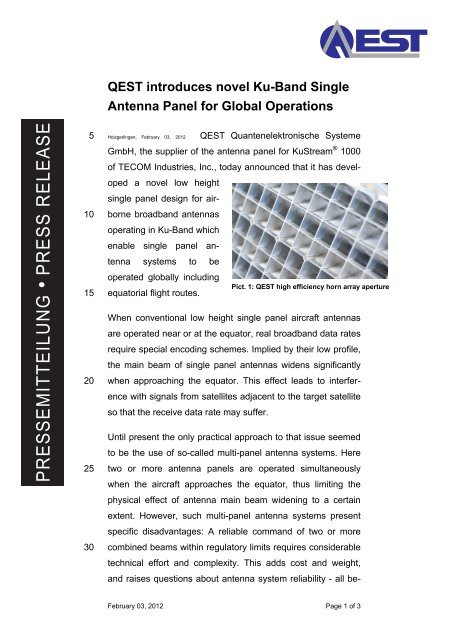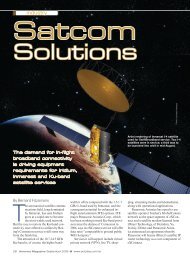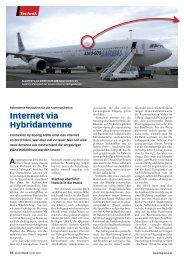QEST introduces novel Ku-Band Single Antenna Panel for Global ...
QEST introduces novel Ku-Band Single Antenna Panel for Global ...
QEST introduces novel Ku-Band Single Antenna Panel for Global ...
Create successful ePaper yourself
Turn your PDF publications into a flip-book with our unique Google optimized e-Paper software.
5<br />
10<br />
15<br />
20<br />
25<br />
30<br />
<strong>QEST</strong> <strong>introduces</strong> <strong>novel</strong> <strong>Ku</strong>-<strong>Band</strong> <strong>Single</strong><br />
<strong>Antenna</strong> <strong>Panel</strong> <strong>for</strong> <strong>Global</strong> Operations<br />
Holzgerlingen, February 03, 2012 <strong>QEST</strong> Quantenelektronische Systeme<br />
GmbH, the supplier of the antenna panel <strong>for</strong> <strong>Ku</strong>Stream ® 1000<br />
of TECOM Industries, Inc., today announced that it has developed<br />
a <strong>novel</strong> low height<br />
single panel design <strong>for</strong> airborne<br />
broadband antennas<br />
operating in <strong>Ku</strong>-<strong>Band</strong> which<br />
enable single panel antenna<br />
systems to be<br />
operated globally including<br />
equatorial flight routes.<br />
Pict. 1: <strong>QEST</strong> high efficiency horn array aperture<br />
When conventional low height single panel aircraft antennas<br />
are operated near or at the equator, real broadband data rates<br />
require special encoding schemes. Implied by their low profile,<br />
the main beam of single panel antennas widens significantly<br />
when approaching the equator. This effect leads to interference<br />
with signals from satellites adjacent to the target satellite<br />
so that the receive data rate may suffer.<br />
Until present the only practical approach to that issue seemed<br />
to be the use of so-called multi-panel antenna systems. Here<br />
two or more antenna panels are operated simultaneously<br />
when the aircraft approaches the equator, thus limiting the<br />
physical effect of antenna main beam widening to a certain<br />
extent. However, such multi-panel antenna systems present<br />
specific disadvantages: A reliable command of two or more<br />
combined beams within regulatory limits requires considerable<br />
technical ef<strong>for</strong>t and complexity. This adds cost and weight,<br />
and raises questions about antenna system reliability - all be-<br />
February 03, 2012 Page 1 of 3
35<br />
40<br />
45<br />
50<br />
55<br />
60<br />
ing major criteria <strong>for</strong> airlines looking <strong>for</strong> connectivity solutions.<br />
By construction the antenna efficiency of multi-panel systems<br />
is rather low, unnecessarily increasing the overall antenna<br />
system size. Inoperative - thus useless - in higher latitudes,<br />
the additional panels are needed in a small region around the<br />
equator only. About 90% of all commercial aircraft flight routes<br />
do not touch that region, and most of the affected routes are<br />
typically crossed in a relatively short period of time. Altogether,<br />
multi-panel antenna systems don’t seem to offer balanced<br />
economic solutions <strong>for</strong> commercial aircraft applications.<br />
Based on its advanced technologies and its extensive experience<br />
in the field of satellite antennas <strong>for</strong> commercial aircraft,<br />
<strong>QEST</strong> has now succeeded in designing a low height single<br />
panel that significantly reduces Adjacent Satellite Interference<br />
also <strong>for</strong> large geographical skew angles, i.e. <strong>for</strong> the regions at<br />
and around the equator.<br />
The basis <strong>for</strong> that is <strong>QEST</strong>’s proprietary and field proven horn<br />
array antenna panel which is already installed on more than<br />
200 commercial aircraft today. Despite its small size (60cm x<br />
16cm only), this single panel solution offers superior per<strong>for</strong>mance<br />
in both transmit and receive operations. By applying<br />
advanced antenna beam engineering to the new panel, Adjacent<br />
Satellite Interference has been reduced significantly while<br />
preserving antenna dimensions and per<strong>for</strong>mance.<br />
<strong>Antenna</strong> systems using <strong>QEST</strong>’s <strong>novel</strong> single panel can be operated<br />
within the global coverage area of geostationary<br />
satellites at broadband data rates with standard providing<br />
schemes. Even at the equator, the improved antenna beam<br />
shaping enables large bi-directional data volumes. The advantages<br />
of single panel antenna systems with respect to<br />
robustness, reliability and costs are now also fully available in<br />
equatorial regions.<br />
February 03, 2012 Page 2 of 3
65<br />
70<br />
75<br />
80<br />
"Based on <strong>QEST</strong>'s advanced antenna technology we have<br />
achieved another breakthrough in the field of aeronautical<br />
broadband antennas", comments Dr. Joerg Oppenlaender,<br />
CTO of <strong>QEST</strong>. "The equatorial per<strong>for</strong>mance of our improved<br />
<strong>Ku</strong>-<strong>Band</strong> single panel is now comparable to far more complex<br />
multi-panel antennas. Finally, <strong>Ku</strong>-<strong>Band</strong> global broadband operations<br />
can be provided by a field-proven and most reliable<br />
antenna technology." And he adds: "Of course, <strong>QEST</strong> will be<br />
using similar technologies <strong>for</strong> its Ka-<strong>Band</strong> single panels which<br />
will reach prototype testing phase very soon".<br />
"The new <strong>QEST</strong> single panel has the potential of presenting<br />
significant cost savings <strong>for</strong> service providers and airlines”,<br />
supplements Michael Stobinski, <strong>QEST</strong>'s Director of Sales and<br />
Marketing, "facilitating a true global broadband connectivity<br />
offer to passengers.”<br />
-----------------------------------------------------------------------------------------------------------------------------<br />
Pict. 1: <strong>QEST</strong> high efficiency horn array aperture<br />
<strong>Ku</strong>Stream ® is a registered trademark of TECOM Industries, Inc.<br />
<strong>QEST</strong> Airborne Broadband <strong>Antenna</strong>s<br />
<strong>QEST</strong> Quantenelektronische Systeme GmbH designs, develops and manufactures<br />
<strong>novel</strong>, small-sized and lightweight Airborne Broadband <strong>Antenna</strong>s with integrated<br />
multi-band capability and superior per<strong>for</strong>mance.<br />
The company’s annual production output is more than 300 antenna systems.<br />
<strong>QEST</strong> is based in Holzgerlingen, Germany – www.qest.de<br />
February 03, 2012 Page 3 of 3<br />
<strong>QEST</strong> Quantenelektronische<br />
Systeme GmbH<br />
Max-Eyth-Str. 38<br />
71088 Holzgerlingen, Germany<br />
Michael Stobinski<br />
Director Sales & Marketing<br />
Tel: +49 7031 20495-10<br />
Mobile: +49 162 2817 659<br />
Fax: +49 7031 20495-69<br />
michael.stobinski@qest.de<br />
www.qest.de




